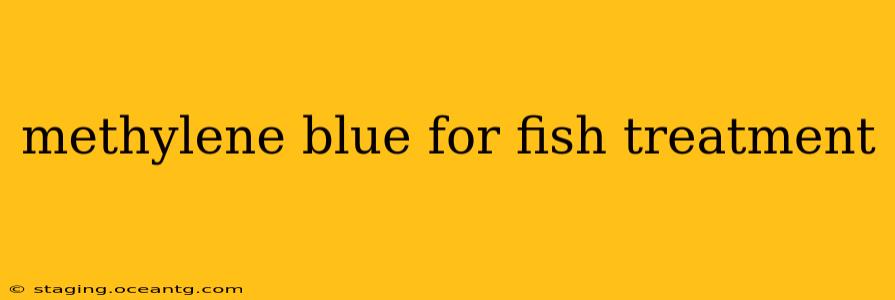Methylene blue is a common medication used in aquariums to treat various fish diseases. Its versatility and relative safety (when used correctly) make it a staple in many fish keepers' medicine cabinets. However, understanding its proper application is crucial for effective treatment and to avoid harming your fish. This comprehensive guide will delve into the uses, precautions, and application of methylene blue for fish treatment.
What is Methylene Blue?
Methylene blue is a chemical compound with potent antiseptic and antiparasitic properties. In the aquarium context, it's used to combat a range of bacterial and parasitic infections in freshwater and saltwater fish. Its vibrant blue color is a result of its chemical structure, which allows it to effectively target certain microorganisms. It's important to note that methylene blue is not a cure-all, and its effectiveness varies depending on the specific ailment and its severity.
What Diseases Does Methylene Blue Treat?
Methylene blue's effectiveness lies in its ability to address several common fish health problems:
- Bacterial Infections: It can help combat certain bacterial infections that manifest as fin rot, cloudy eyes, or other external lesions. However, it's not effective against all types of bacterial infections. A proper diagnosis is vital.
- Parasitic Infections: Methylene blue is effective against certain external parasites like Ich (Ichthyophthirius multifiliis), also known as white spot disease, which causes small white spots on the fish's body. It can also help with some fungal infections.
- Wound Treatment: Its antiseptic properties can aid in the healing of minor wounds and abrasions.
How Does Methylene Blue Work?
Methylene blue works by oxidizing harmful microorganisms, effectively disrupting their metabolic processes and leading to their destruction. Its mechanism of action is complex and involves several biochemical pathways.
How to Use Methylene Blue for Fish Treatment
The dosage of methylene blue varies depending on the severity of the illness and the type of fish. Always start with the lowest effective dose and monitor your fish closely. Overdosing can be harmful. Always follow the instructions provided on the specific product you are using. Generic instructions are not a substitute for product-specific guidance.
Typically, a dosage of 1-2 mg/L (milligrams per liter) is a common starting point for many infections. This means adding a small amount of methylene blue to your aquarium water to achieve the desired concentration. Using a precise measuring device (e.g., a calibrated dropper or syringe) is essential for accurate dosing.
Note: The color change in the water is not a reliable indicator of effective concentration.
How Long Should I Treat My Fish with Methylene Blue?
Treatment duration usually lasts for several days, often 3-5 days. However, the exact duration depends on the specific condition being treated and the fish's response. Closely monitoring your fish for improvement is crucial. If no improvement is observed after a few days, consult a veterinarian specializing in aquatic animals.
What are the Side Effects of Methylene Blue?
While generally safe when used correctly, methylene blue can have side effects, particularly if overused or improperly applied. These can include:
- Stress in Fish: Improper dosing or extended treatment can stress the fish.
- Water Quality Issues: High concentrations can temporarily impact water parameters, especially oxygen levels.
- Staining: The blue dye can stain decorations and other aquarium elements.
What are the Precautions to Take When Using Methylene Blue?
- Proper Diagnosis: Before using methylene blue, ensure that you have correctly diagnosed the underlying health issue. Misdiagnosis can lead to ineffective treatment or even harm to your fish.
- Accurate Dosing: Always carefully measure the correct dose. Using too much methylene blue can be toxic to fish.
- Water Changes: After the treatment period, perform significant water changes to remove the remaining dye and restore water quality.
- Carbon Filtration: Activating your carbon filter can help remove the methylene blue from the water once treatment is complete.
- Quarantine: If possible, treat infected fish in a quarantine tank to prevent the spread of disease to other fish.
Can Methylene Blue Be Used with Other Medications?
Never use methylene blue in conjunction with other medications without consulting a veterinarian specializing in aquatic animals. Interactions can occur, potentially reducing the effectiveness of one or both medications or even creating toxic combinations.
Is Methylene Blue Safe for All Fish?
While generally safe for many fish species, certain species may be more sensitive to methylene blue than others. Always research the specific needs of your fish before using any medication.
Where Can I Buy Methylene Blue for Fish?
Methylene blue for fish treatment is readily available at most pet stores that carry aquarium supplies, as well as online retailers specializing in aquarium products.
This information is for educational purposes only and does not constitute veterinary advice. Always consult with a qualified veterinarian specializing in aquatic animals for any health concerns regarding your fish. Remember that responsible fish keeping includes proactive disease prevention through proper water maintenance and quarantine procedures.
